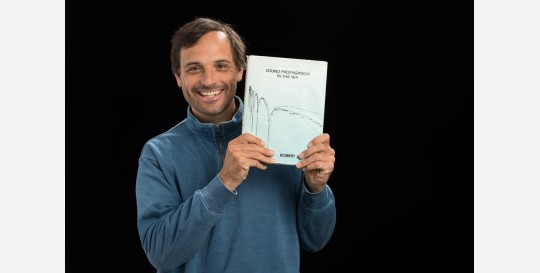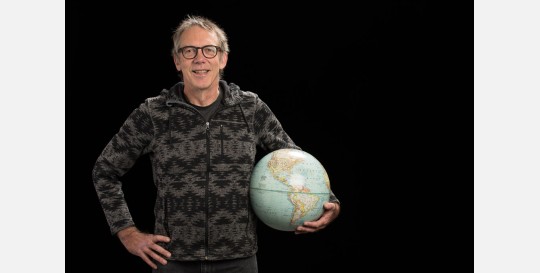Suspended Matter and Seabed Monitoring and Modelling (SUMO)
Sediment transport
Deposits of sand and mud (sediments) lie on the seabed. A difference is made between non-cohesive material (which does not stick together) and cohesive material (grains that stick together). The non-cohesive material is fine to coarse sand, with a grain size of between 63 µm (0.063 mm) and 2 mm, and gravel, with a grain size greater than 2 mm. Under the influence of the currents and waves these sediments are displaced. The sand and gravel are displaced primarily as “bed load transport” with a rolling action over the seabed. The cohesive material is the finer material, the mud and clay particles, with a grain size of under 63 µm. When there are strong currents this finer sediment will rise up and enter the water column with which it is displaced. As soon as the friction between the water and the seabed (the bottom tension) falls back below a certain level, the suspended material again falls to the seabed. These small particles will also stick the one to the other to form larger flocs. Depending on, among other things, the strength of the currents, the quantity of biological material in the water and the turbulence these flocs will either grow or be broken down again.
Sand and mud are transported by currents and waves and this sediment transport is closely studied in order to be able to better manage sand extraction and depositing of dredging material.

Measurements
An initial important aspect of the research into sediment transport is to carry out measurements at sea. For this we have a number of measuring instruments at our disposal.
The currents, the principal cause of the sediment transport, can be measured using an Acoustic Current Doppler Profiler (ADCP) installed on the oceanographic research vessel RV Belgica or placed on the seabed. It is able to measure a complete current profile at a given point.
The quantity of fine material in suspension and the sediment transport near the bottom is measured using the ‘tripod’. This is a large iron frame that is also placed on the seabed and to which instruments can be fitted to measure various parameters over a longer period. The CTD sensor measures the temperature and salt content of the water. Optical Back Scatters measure the turbidityat various heights above the seabed. To know exactly how much material is present in the water, water samples are also taken from on board the RV Belgica, using Niskin bottles. These water samples are filtered to determine the exact concentration of the sediment in the water and to determine the relationship between the material in the water and the measured turbidity. On land these water samples are studied further to determine the grain distribution and quantity of organic material.
An electromagnetic flowmeter capable of measuring in high resolution is also installed on the tripod. It measures the flows at a given point, while a small ADCP can determine the flow profile close to the seabed. Finally, a Laser In-Situ Scattering and Transmissionmeter (LISST) sensor is fitted to the tripod. This is able to estimate sediment particles and trends in the size of mud flocs in the water, on the basis of which the floc fall velocity can be calculated.
In addition to measuring the flows and sediment quantities in the water, it is also important to know what kind of sediment is present on the seabed. Seabed samples are taken with a Van Veen Grab that extracts a quantity of material from the seabed for subsequent laboratory analysis on land.
In cooperation with the REMSEM-team, satellite images are also used to estimate suspended material in the Belgian area.

Numerical models
In addition to the measurements, OD Natural Environment develops various hydrodynamical models that seek to describe the sea behaviour. These models are then used for forecasts and to evaluate the effect of certain parameters or management actions. At present two transport models are available: a sediment transport model and a sand transport model.
The sediment transport model (mu-STM) is a model that determines the movement of the fine cohesive material. It is an advection-diffusion model: it determines the movement (advection) and spread (diffusion) of the mud. It is also a ‘Lagrangian’ model, meaning that a given quantity of material is monitored as it moves through the model grid. This is in contrast to the Eulerian model in which the quantity of material is determined at each grid point. Allowance is made for erosion and return deposits of material.
The mu-STM model is initially used to model the behaviour of dredging spoil that is dumped in the sea. This serves to validate the model: the model results are checked and compared to measurements obtained by experiments at sea. In this way it is possible to identify sites where the dredging sediment does not seem to move or where the mud is displaced from its original site by dredging.
The model is subsequently used to draw up a “mud balance” for the entire Belgian part of the North Sea: the quantity of mud that enters Belgian coastal waters and the quantity that disappears from it were measured. The concentration on the model fringes is determined using satellite images. The model showes that there is a major mud flow from the English Channel along the Belgian coastal waters to the North Sea. The maximum turbidity (maximum quantity of material in the water) is the effect of a kind of blockage of the material and the shallower waters at the mouth of the Scheldt.
The mu-STM model is also used to successfully model the growth of a new “sandbank” at Heist, east of the Port of Zeebrugge harbour wall.
The sand transport model (mu-SEDIM) models sand movements. At each grid point it calculates the sediment transport and the direction, on the basis of the local currents and waves. In this case, erosion and sedimentation are determined by means of the “divergence” of the transport within a grid cell, which means that the quantity of sand that enters and leaves each grid cell is determined. If more material enters than leaves, there will be deposits. In the opposite case, there will be erosion. In this way bottom changes can be calculated.
This sand transport model is applied principally for modelling transport on the sandbanks, for example when installing offshore wind farms. The model is also used to model the effects of large-scale extraction of sand at sea and from sandbanks. The model appears to show that extracting sand from sandbanks does not jeopardise sandbank stability and offers a mechanism for the “regeneration” of the sandbanks.

Further research
- Development of a model that can model the transport of both sand and mud and that can take into account the interaction between the two.
- Development of an adapted model to model the size of mud flocs in the water and related fall velocity.
- The use of satellite images to improve the information on the mud in the water.
- Development of an operational management instrument, based on the sediment transport models, than can be used for operational forecasting of sand and mud transport. This management instrument could be used to determine the best dumping or sand extraction site, account taken of the prevailing meteorological conditions and other parameters.




